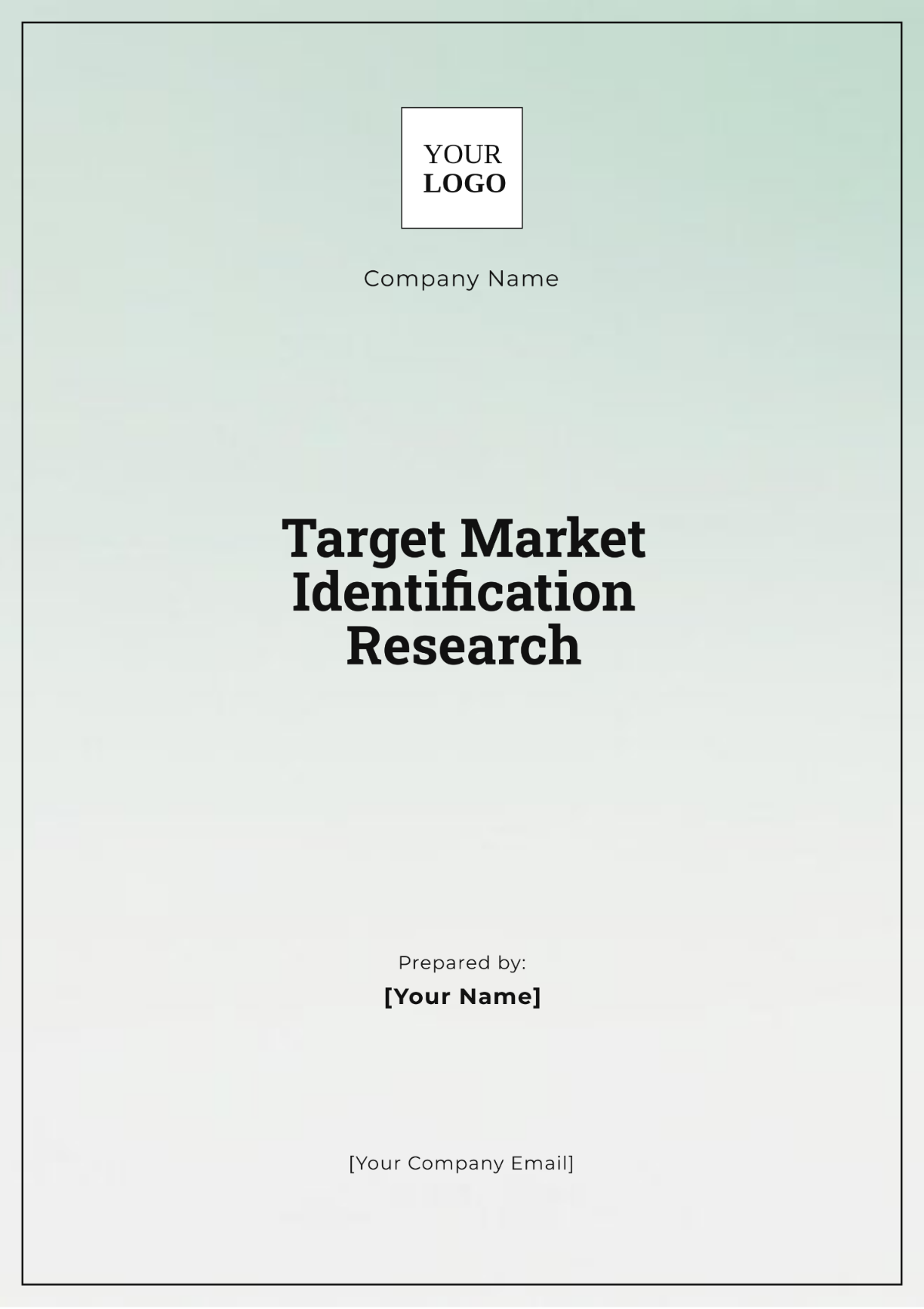Free Target Market Identification Research

Company: [Your Company Name]
Researcher: [Your Name]
Market research is crucial for understanding the demographics, behaviors, and preferences of potential customers. This document outlines a standard approach to identifying a target market for a hypothetical business venture in 2055. The research focuses on capturing the essential elements needed for a comprehensive understanding of the target market.
I. Introduction
A. Objectives
Identify the primary target market for a futuristic product: the EcoSmart Urban Transporter (EUT).
Analyze demographic and psychographic characteristics of potential customers.
Evaluate market needs and trends that may influence purchasing decisions.
Provide actionable insights to inform marketing strategies.
B. Key Findings
The primary target market consists of urban professionals aged 25-45.
Sustainability and technology integration are key purchase drivers.
Increasing demand for eco-friendly and efficient transportation solutions.
High adoption rates of smart technology among target demographics.
II. Market Overview
A. Industry Background
The global transportation industry in 2055 is characterized by rapid advancements in eco-friendly technologies and smart city initiatives. Urban areas are adopting sustainable transport solutions to combat congestion and pollution.
B. Market Trends
Eco-friendly Solutions: There is a significant shift towards environmentally sustainable products, driven by consumer demand and government regulations.
Smart Technologies: Integration of AI and IoT in transport systems is becoming a standard requirement.
Urbanization: Continued growth of urban populations increases demand for innovative transportation solutions.
C. Competitive Landscape
Major Competitors: These include companies like Tesla NextGen, EcoTransport Inc., and GreenMotion.
Market Position: The EUT aims to capture a niche segment focused on sustainability and smart technology integration.
III. Target Market Analysis
A. Demographics
Attribute | Description |
|---|---|
Age Range | 25-45 |
Gender | 55% Male, 45% Female |
Income Level | $80,000 - $150,000 annually |
Education Level | College-educated, with a focus on STEM fields |
Geographic Area | Urban centers in North America and Europe |
B. Psychographics
Attribute | Description |
|---|---|
Lifestyle | Environmentally conscious, tech-savvy, health-focused |
Values | Sustainability, innovation, convenience |
Interests | Technology, travel, urban living |
Personality Traits | Early adopters, trendsetters, socially responsible |
Buying Motivation | Efficiency, environmental impact, social status |
C. Customer Needs
Efficiency: Desire for quick and reliable transportation.
Sustainability: Preference for eco-friendly options that reduce carbon footprint.
Convenience: Need for seamless integration with smart city infrastructure.
Innovation: Attraction to cutting-edge technology and futuristic design.
IV. Competitive Analysis
A. Major Competitors
Company | Strengths | Weaknesses |
|---|---|---|
Tesla NextGen | Strong brand recognition, advanced AI | High cost, limited customization |
EcoTransport Inc. | Focus on sustainability, affordable | Less technological innovation |
GreenMotion | Innovative designs, smart features | Smaller market presence |
B. SWOT Analysis
Strengths | Weaknesses | Opportunities | Threats |
|---|---|---|---|
|
|
|
|
V. Market Segmentation
A. Segmentation Criteria
Demographic Segmentation: Age, income, education level.
Geographic Segmentation: Focus on urban areas with high traffic congestion.
Behavioral Segmentation: Purchase behavior, brand loyalty.
Psychographic Segmentation: Lifestyle, values, interests.
B. Segment Profiles
Urban Professionals
Description: Young professionals working in metropolitan areas.
Needs: Efficient commuting solutions, and eco-friendly options.
Marketing Strategy: Emphasize convenience and sustainability.
Tech Enthusiasts
Description: Individuals who are early adopters of new technology.
Needs: Cutting-edge features, and seamless integration with smart devices.
Marketing Strategy: Highlight innovative technology and design.
Environmentally Conscious Consumers
Description: Consumers who prioritize sustainability in their purchases.
Needs: Products with minimal environmental impact, and social responsibility.
Marketing Strategy: Focus on the environmental benefits of the EUT.
VI. Marketing Strategy
A. Product Positioning
The EUT is positioned as a premium eco-friendly urban transportation solution that combines sustainability with smart technology.
B. Pricing Strategy
Competitive Pricing: Align pricing with market expectations while emphasizing value.
Tiered Pricing: Offer different models with varying features to cater to different income levels.
C. Promotion Strategy
Digital Marketing: Leverage social media, influencers, and online advertising to reach target demographics.
Experiential Marketing: Offer test drives and demonstrations in urban areas.
Partnerships: Collaborate with smart city initiatives and environmental organizations.
D. Distribution Strategy
Direct Sales: Online platform for direct customer purchases.
Retail Partnerships: Collaborate with tech and eco-friendly retailers.
Urban Showrooms: Establish showrooms in major metropolitan areas for product display and testing.
VII. Customer Feedback and Iteration
A. Feedback Mechanisms
Surveys and Questionnaires: Collect customer opinions and preferences.
Focus Groups: Engage target market segments for in-depth discussions.
Social Media Monitoring: Analyze online conversations and feedback.
B. Iteration Process
Product Improvements: Adjust features based on customer feedback.
Marketing Adjustments: Optimize strategies to meet consumer expectations.
Innovation: Continuously incorporate new technologies and trends.
VIII. Conclusion and Recommendations
A. Summary of Findings
The target market for the EUT is comprised of urban professionals, tech enthusiasts, and environmentally conscious consumers.
There is a strong demand for eco-friendly, technologically advanced transportation solutions.
Effective market segmentation and tailored marketing strategies are essential for success.
B. Strategic Recommendations
Enhance Brand Awareness: Increase visibility through targeted marketing campaigns.
Focus on Customer Experience: Prioritize user-friendly features and seamless integration.
Expand Market Reach: Explore opportunities in emerging markets and developing urban areas.
Monitor Market Trends: Stay ahead of industry trends and technological advancements.
C. Final Thoughts
By understanding the target market's demographics, psychographics, and needs, the EUT can successfully position itself as a leader in sustainable urban transportation solutions for 2055 and in the future.
- 100% Customizable, free editor
- Access 1 Million+ Templates, photo’s & graphics
- Download or share as a template
- Click and replace photos, graphics, text, backgrounds
- Resize, crop, AI write & more
- Access advanced editor
Pinpoint your target audience effortlessly with Template.net’s Target Market Identification Research Template. Customizable and editable in our AI Editor Tool, this template guides you through identifying key market segments and consumer profiles. Perfect for businesses seeking to refine their marketing efforts, this tool provides a structured approach to understanding audience needs.





























